A “virtual” Second World War Walk From The Valley To The White Swan
15/08/2019 - 10.26
Stephen Hunnisett
Our walk started outside the famous “Covered End” of The Valley. It was at the opposite end of the ground that the famous image was taken of a spotter on the lookout for enemy aircraft overhead.
Football grounds, along with all other sports venues and places of entertainment, had initially been closed under the terms of the Emergency Powers (Defence) Act of 1939. This was driven by the fear of large-scale air raids against British towns and cities almost immediately following the declaration of war. These air raids failed to materialise and instead the country settled into a strange period that became known as “The Phoney War”, during which as far as most civilians were concerned, not very much seemed to be happening. As a result of this, coupled with considerable public disquiet, places of entertainment were allowed to resume business. Football was also allowed to resume but on a far more localised basis than before and if enemy aircraft were sighted or the air raid alert sounded, the orders were that play had to be halted immediately.
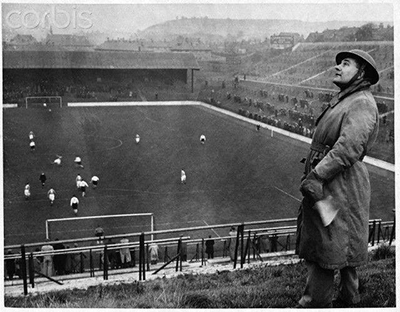
[ARP Spotter at The Valley – Greenwich Heritage Centre]
We then walked a short distance along Harvey Gardens and paused adjacent to the Ransom Road Railway Bridge. This seemingly innocuous pathway beneath the North Kent Railway was bricked over and reinforced to form a public Air Raid Shelter capable of accommodating 80 people. These public shelters were unsanitary and not especially safe but in the early days of the war, were sometimes the only option available to local people. Standing at this spot now, it is hard to imagine that Charlton residents would regularly spend their nights during the Blitz of 1940-41 trying to snatch a disturbed sleep underneath the arches.
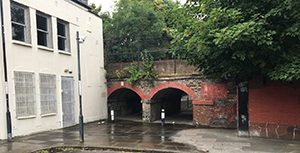
[Ransom Road Arches – Author’s Photo]
We then walked along Floyd Road, passing numbers 55-61 along the way. These were all destroyed by a High Explosive bomb on the night of 11 September 1940, although fortunately without loss of life – perhaps their occupants were in the shelters beneath the arches?
We then proceeded and paused at the corner of Floyd Road/Charlton Church Lane and opposite Delafield Road. Charlton Railway Station was destroyed at 15:04 on 23 June 1944 by a V-1 Flying Bomb with the loss of four lives, including Mrs Newick, the wife of the Station Master. Another of those killed was William Brown, an engineer at the BBC but also a member of the 5th County of London Bn., Home Guard. For some inexplicable reason, he left work early that day and was unfortunate enough to be passing through the station as the V-1 hit. I’ve subsequently spoken to his daughter Joan Longley, who lived in Charlton Church Lane. She was too young to attend her Daddy’s funeral but remembered standing on top of her family’s Anderson Shelter to watch the cortege passing her home.
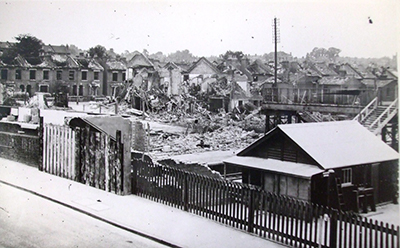
[Charlton Station Damage – Greenwich Heritage Centre]
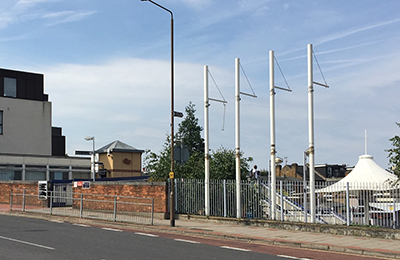
[Charlton Station 2019 View – Author’s Photo]
We then began to ascend Charlton Church Lane but paused outside the Charlton Conservative Club. During WW2, this was the site of Wardens’ Post “Park 9” which would have been a structure similar to that which is still extant just a mile or so up the hill at Blackheath, in the grounds of the New Bridge Club.

[Surviving Wardens’ Post Blackheath – Author’s Photo]
ARP Wardens were somewhat maligned during the early – “Phoney War” – period and indeed, the comedian Bud Flanagan used to say the ARP wasn’t an abbreviation for Air Raid Precautions but rather for ‘Anging ‘Round Pubs! The public view of them was very similar to the portrayal of Mr Hodges in Dad’s Army – as rather officious busybodies, whose main purpose in life was shouting at people to “Put That Light Out!” Experience gained during the Blitz placed the Wardens in a rather softer light and the public finally recognised that in the main, they were dedicated local volunteers doing their bit to help defend their local neighbourhood.
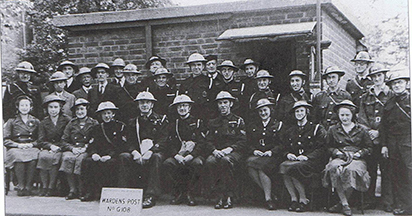
[Local Air Raid Wardens – Author’s Collection]
We kept on the subject of the Wardens as we proceeded up the hill and paused on the wide pavement outside St Luke’s Church. My Grandfather was an Air Raid Warden and was frequently stationed atop the church tower on fire-watching duties. On the evening of 26 January 1945, nearby Charlton House was “winged” by a V-2 Rocket, which caused serious damage to the Jacobean Manor House. The photographs show rebuilding work in progress, during which bricks of a different size and colour were used, which allows us to clearly see the extent of the damage. Amazingly, nobody was killed but extensive blast damage was caused to over two hundred surrounding houses – including mine two streets away. Here, the upstairs ceilings were repaired in a distinctive style using large sheets of plasterboard joined with timber battens, which are still there to this day and which serve as my own private war memorial.

[Charlton House Damage Repairs – Historic England]
Before we headed to the pub, we remembered that both of The Village pubs were damaged during the war – perhaps Hitler had a vendetta against the beer drinkers of Charlton! On 11 November 1940, the Bugle Horn was badly damaged by a High Explosive bomb, whilst earlier on 17 October, the White Swan had also been badly damaged by a High Explosive bomb which destroyed the Siemen’s Social Club next door and which eventually caused the upper floor of the pub to be demolished, leaving the building with its present-day slightly cropped look.

[White Swan Pub – Author’s Collection]
On completion of this walk, the party repaired into the White Swan to undertake some vital research into the comparative merits of the various beers of Southeast London before enjoying the evening programme of seminar talks.
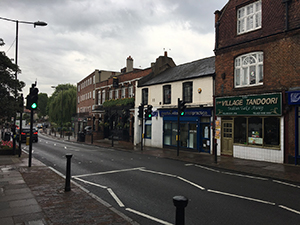
[White Swan Pub 2019 (minus top floor) – Author’s Photo]
Biography
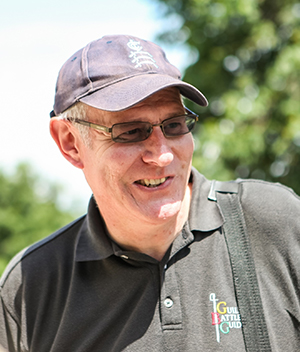
Steve is now a full time Battlefield Guide, military history blogger and researcher, specialising in the Home Front and London at war in particular, who took the plunge into self-employment in 2015. He is a Southeast London boy by birth and splits his football watching time between Charlton Athletic and Dulwich Hamlet FC, being a season ticket holder at both clubs. He has developed a great interest in the history and heritage of both these community-oriented clubs and is the author of ‘For Freedom’, which tells the story of Dulwich Hamlet’s Second World War casualties.


/prod01/wlvacuk/media/departments/digital-content-and-communications/images-2024/240624-Alumni-Awards-2024-Resized.jpg)
/prod01/wlvacuk/media/departments/digital-content-and-communications/images-18-19/220325-Engineers_teach_thumbail.jpg)
/prod01/wlvacuk/media/departments/digital-content-and-communications/images-2024/240627-UN-Speaker-Resized.jpg)
/prod01/wlvacuk/media/departments/digital-content-and-communications/images-2024/240320-Uzbekistan-Resized.jpg)
/prod01/wlvacuk/media/departments/digital-content-and-communications/images-2024/240229-The-Link-Resized.jpg)
/prod01/wlvacuk/media/departments/digital-content-and-communications/images-2024/240627-Lady-Aruna-Building-Naming-Resized.jpg)